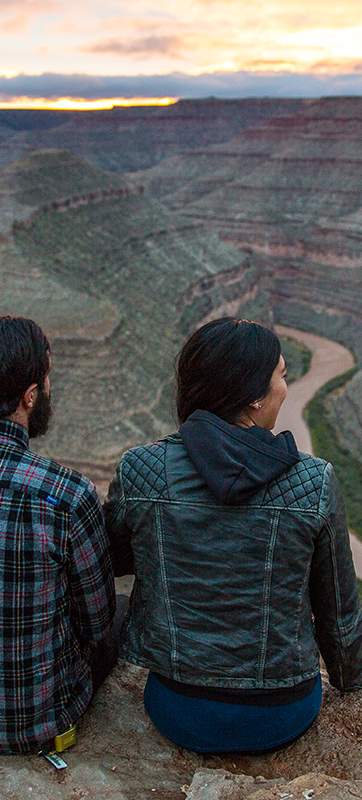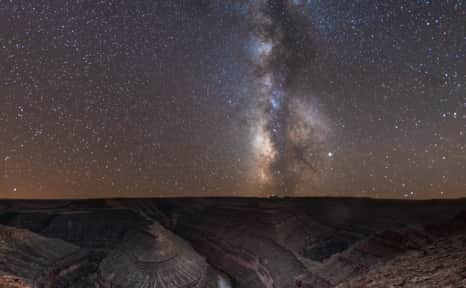
Goosenecks State Park
What Makes it Great
The goosenecks of the San Juan are a rare and amazing geologic formation. And this viewpoint of the river is easy to get to. Take the paved road to the park and see how the river carved a gorge into the plateau. Peer down 1,000 feet to the river below and extend your view to formations as far away as Arizona. The canyon walls are made from shale and limestone and are over 300 million years old.
The river loops several times from the main vantage point. Over 1.5 miles as the crow flies, the river flows six miles due to the crooked bends in the San Juan. You can travel down dirt roads in either direction from the main area to find more views, but a high-clearance vehicle is recommended, and you should note that there is no access directly to the river from the park road. However, an unmarked trail nearby called Honaker Trail will get you down to the water level, although it is quite a rugged route.
Goosenecks State Park is an incredible place to take panoramic photographs and night sky photos—the park was certified as an International Dark Sky Park in March 2021. Because of its remoteness, there is little light pollution, and the stargazing here is some of the best in Utah. In addition, this park makes for a pleasant picnic spot and camping destination.
What You’ll Remember
Craning your neck to see the full goosenecks from the viewing platform, standing in awe at this geological marvel, gawking at how winding and twisting a river can run, the colorful hues from desolate geography when the light is just right.
Park Fees and Information
Goosenecks is open year-round, but check the weather before you go — during the summer, there is no shade, and temperatures can exceed double digits. The best time of year to enjoy Goosenecks State Park is spring and fall when temperatures are lower and more tolerable. The best times for photography, sunrise and sunset, also happen to be milder and more enjoyable in the summer. Dogs are allowed in the park but must stay on a leash.
A day-use entry fee is required and will cost you $5 per vehicle, which you can purchase in person or online. The Annual Utah State Park Pass is accepted for park entry. Primitive camping is first-come, first-served only, with no reservations; there is a $10 camping fee per night. If camping, be advised that Goosenecks State Park can be rather windy, so it is best not to camp along the cliff’s edge, although it seems like the most scenic and best option; instead, opt for something more inland. This park has a pit toilet but no other amenities like running water. The nearby town of Mexican Hat is small but offers lodging and a few restaurants."You probably don’t realize it yet, but you love entrenched meanders. Said in plain English, entrenched meanders are the deeply-cut river bends that make you want to pull out your camera and take a photograph."

Goosenecks State Park was certified as an International Dark Sky Park in March 2021.

Goosenecks State Park is one of the greatest places in Utah to see magnificent erosional feats.
Things to Do
-
Boating and Fishing
Take to the tranquil waters of the San Juan River and experience the serenity of Goosenecks State Park from a different perspective. Whether casting your line in search of trophy fish or simply enjoying a leisurely paddle, the river offers endless opportunities for outdoor enjoyment.
-
Camping
Unwind beneath the vast desert sky and immerse yourself in the tranquility of Goosenecks State Park. Experience the magic of sleeping under the stars in one of Utah's most breathtaking settings.
-
Hiking
Discover breathtaking vistas and captivating landscapes as you traverse Goosenecks State Park’s scenic hiking trails. From strolls to challenging treks, there's a trail offering every level of adventure.
-
Mountain Biking
Saddle up and explore the park's rugged terrain on two wheels. Mountain biking enthusiasts will revel in the exhilarating trails, which offer diverse challenges and stunning views around every bend.
What's Nearby
-
Cliff Dwellings and Sites
Your mind will wonder at just how the Ancestral Puebloan people built these structures high on cliffs and what their day-to-day life was like.
-
Monument Valley Navajo Tribal Park
Monument Valley Navajo Tribal Park features towering sandstone rock formations, sculpted over 300 million years, that soar 400 to 1,000 feet above the valley floor.
-
Natural Bridges National Monument
As you start to descend toward Natural Bridges National Monument, the groundcover becomes more luxuriant and the trees taller. You cannot see the chaotic landscape of Natural Bridges from the highway– it is only revealed once inside the park.
-
Valley of the Gods
Perhaps one of the most intriguing names of all of the destinations in San Juan County is the Valley of the Gods. This special area attracts individuals looking for idyllic sandstone structures.


